Introduction
We live in a time of constant and sometimes even relentless marketing grappling for our attention.
When we go online, we’re targeted with advertisements according to our demographics, likes, and online activity. In our mailboxes, we often find flyers for everything from local lawn companies to food delivery services. And those commercial breaks we experience (way too often) while watching live television or listening to streaming music are customized based on factors like geographic location and personal interests.
There’s a whole lot of noise out there— and nonprofits must somehow find a place in the midst of this, especially when it comes time to promote an upcoming fundraising campaign.
To meet your organization’s mission and raise enough funds to make a real difference in the world, marketing is absolutely necessary.
By using the different marketing mediums out there, you increase the chances of being heard and bringing donations (and new supporters) into the fold.
But remember, the place you promote is only as important as the messages and the messenger you use. Therefore, CauseVox strongly advises nonprofits and charities to rely on the strong voices of their supporters to help amplify those marketing messages whenever possible. It’s what we call “People Fundraising.”
In this detailed guide, you’ll learn how to effectively promote your fundraising campaign across all channels, incorporating People Fundraising whenever possible.
“Learn how to effectively promote your fundraising campaign across all channels, incorporating People Fundraising.” tweet this
Using People Fundraising to Market Your Fundraising Campaign
Before we dive into the ins and outs of fundraising campaign marketing, it’s important to get a good grasp on the concept of People Fundraising.
Why focus on People Fundraising when there are so many ways to get your message across to donors? Simply put, when your supporters share information about your nonprofit’s fundraising campaign with their networks of friends and family members, it pulls more weight than if these same people read or heard of the campaign on their own.
The power of a recommendation is unparalleled in our world today. According to a 2016 study done in partnership between Ambassador and Nielson’s Harris Poll Online, a colossal 82% of Americans surveyed seek recommendations before making a purchase. Considering what we know about Millennials and Generation X, it’s not at all surprising that this number jumps to 92% for members of the population between 18-34 years old.
There are many ways to get your supporters to share information about your fundraising campaign and we’ll dive into these further along in this guide. In the meantime, keep in mind that People Fundraising is a process. To maximize the impact of supporter-driven marketing, include the following elements:
1. Inspire
When your organization provides the right information and context, you’ll inspire your supporters to help promote your cause (and thus, the campaign). Inspiration takes many forms, including written and visual stories, statistics, infographics, and even in-person speaking events.
2. Active
Once a supporter is inspired to help promote your campaign, it’s important to give them the opportunity to do so. Activation is all about just that—action! Giving supporters a direct call-to-action can help guide them, whether you’re looking for them to share a post on social media, forward an email, or talk with friends in-person about your organization’s campaign.
3. Rally
To keep the energy up, incentivize your supporters to go even further to show their passion for your cause. Rally your supporters by asking them to participate as a personal fundraiser or share a personal story about how they got involved with your organization on their social media page.
When your nonprofit uses People Fundraising to inspire, active, and rally supports to help promote your fundraising campaign, you’re truly maximizing your reach across all possible channels.
Marketing & Promotion Channels
Nonprofit marketing looks very different in 2017 compared to just a few years back. It’s possible that some of your volunteers, board members, donors, and prospective donors aren’t necessarily keen to some of the more traditional marketing mediums. At the same time, you may have another segment of supporters that don’t often go online or are unfamiliar with social media.
To ensure your supporters (and potential supporters) know about your fundraising campaign, regardless of demographics or other factors, diversification of marketing avenues is essential.
Here are some of the most common ways to market your fundraising campaign.
“Here are some of the most common ways to market your fundraising campaign.” tweet this
According to the 2015 M+R Benchmarks study, email giving accounted for 29% of all online revenue last year. For every 1,000 fundraising emails send, nonprofits captured $44. Likewise, email revenue was up 25% from 2014.
What does this mean for your nonprofit? These statistics indicate that email is definitely a consistent way to capture donations.
Fundraising emails vary greatly from one nonprofit to the next and what works for your nonprofit audience may not for another. However, to effectively use email to market your fundraising campaign, follow these tried-and-true fundraising email best practices:
- Understand your audience: As in all marketing efforts, you have to know who you’re talking to. That way, you can send information that is relevant to your supporters such as targeted content based on interests or demographics.
- Use a strong subject line: Create a sense of urgency by writing a subject line that encourages an open. Include time-sensitivity or pose a question to get your audience interested in learning more. Just remember to keep it around 15 characters.
- Personalize the email: Always address your donor by his/her name if possible. Avoid generic greetings if you can.
- Share your nonprofit/campaign story: Always include an element to inspire your email recipients such as a client success story or strong visual.
- Use a strong call-to-action: Activate your supporter into action by ending with a strong, direct call-to-action. Your recipient needs to know exactly what you want them to do.
- Make sure it’s optimized for mobile devices: In 2015, 13% of all online gifts were made through a mobile device and this figure is expected to rise and more of us turn to mobile over PCs and even laptops. Therefore, you want each email to read easily on mobile by using a single column layout and resizing your pictures.
For inspiration, look at this fundraising email sent by World Help. It contains a solid subject line, impactful nonprofit story, emotion-inducing images, and a direct call-to-action.
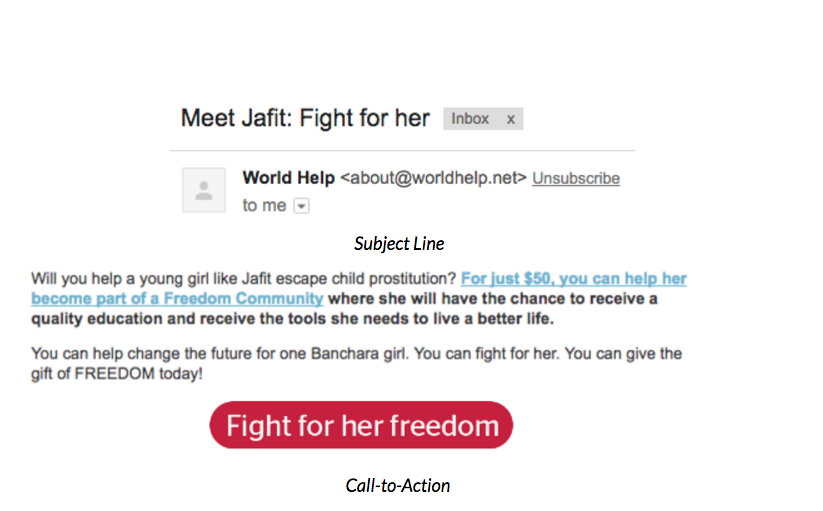
Remember how we mentioned marketing diversity? Email is one of those areas that you can seamlessly link to other marketing mediums, such as directing people to your fundraising website. Another way to diversify is to add social sharing buttons to your emails, a People Fundraising technique that can increase click-through rates by as much as 158%.
Targeted Ads
Nonprofits that choose to invest in digital advertising using targeted ads average $1 of revenue for every $0.04 in advertising fees.
Again, the first step in using targeted ads for your fundraising is to understand your audience. Browse your CRM or other donor management system and pull a few reports. Learn about your average donor age, gender, geographic location, likes/dislikes, average gift, and any other pertinent information.
Then, determine where you want to place your ads. The two most popular places for nonprofits to place ads are Facebook/Instagram and Google.
Facebook/Instagram Ads: Create an ad campaign using Facebook’s Business Manager program that is shared on either Facebook, Instagram, or both platforms. Your ad features a short inspirational feature such as a quote, statistic, or story, a photo/video, and a call-to-action(for example, Donate, Visit Website, Learn More). With this program, you have the ability to set your target audience and budget.For more information, head over to Facebook’s nonprofit ads help page.
Google Ads: Nonprofits create and manage Google-based ads using Google Adwords. You can set your ad campaign to reach potential donors in your geographic location or another target demographic. To help offset the advertising costs, check out Google Grants.
Since most nonprofits are working with a very limited marketing budget, you may have to choose one of these digital advertising platforms over the other. So, which one should you choose?
That depends entirely on how well you know your audience. Facebook ads are more geared toward your current followers and their networks. If you have a strong social media following, Facebook/Instagram ads are probably your best bet. For nonprofits with a less-than-stellar social media audience, Google Ads is a great alternative option.
Keep in mind that most ads are going to drive the audience to your fundraising website or social media posting. Therefore, targeted ads are a great way to help get the conversation started across multiple marketing avenues.
Social Media
Per the M+R Benchmarks survey, for every 1,000 email subscribers, the average charitable organization has 355 Facebook fans, 132 Twitter followers, and 19 Instagram followers. Yet, it doesn’t matter if you have 10 followers or 1,000, what matters is that you’re reaching your audience effectively.
We talked about Facebook/Instagram ads above (targeted ads) and this marketing method is definitely a great way to get in front of a large audience of current and new donors. But you don’t necessarily have to pay for Facebook ads if you’re simply looking to mobilize your current followers into action. In fact, Facebook, Instagram, Twitter, Pinterest and any other social media platform that you use is basically a free marketing tool for your organization.
Not only can you post about your fundraising campaign, share nonprofit stories, upload images and videos, and direct people to your website all through social media posts, you can also increase your reach exponentially by using People Fundraising methods.
First things first, here are some of the best ways to use social media to promote your fundraising campaign.
- Give your audience fair warning about the beginning of any fundraising campaign. Let them know when it’s going to start, your goal, and the intended impact.
- Provide information that your followers will not only be inspired by, but want to share, including statistics and stories to inspire action.
- Link to blogs and other impactful content featured on your website
- End every post with a specific call-to-action
- Finish your campaign with a summary of the results
Next, encourage your followers to help you fundraise by having them do one or more of these People Fundraising activities:
- Share your campaign post
- Interact/engage with your posts (Like, comment, retweet)
- Fundraise for your organization as a personal fundraiser
To get you thinking about how to best use social media to promote your fundraising email campaign, take a look at these examples.
Humanility uses Facebook to promote their peer-to-peer fundraising campaign.
In this simple yet effective post, Washington Coast Works thanks donors, gives a campaign update, and requests that people share the campaign.
Social media marketing works seamlessly alongside digital advertising and fundraising email campaigns and is highly effective in not just bringing in donations, but engaging your audience and reaching new prospects. In a nutshell, social media is the perfect way to People Fundraise!
Direct Mail
Compared to online fundraising, direct mail requires a significant upfront cost, but is it worth it? Oftentimes, yes!
The best audience to reach via direct mail is your current, active donors. While you may be tempted to reach out to prospects using this marketing medium, the return is statistically low.
To create waves using direct mail to promote your fundraising campaign, follow these tips:
- Mail only to current donors who’ve given in the last 12 months and who have agreed to receive mail communications
- Refer to the donor directly by name and also mention the impact of their last gift
- Share a story and use images
- Ask for a specific gift amount or use gift tiers
- If you can’t personally sign every mailing, at the very least use the CEO, Board President or fundraising manager’s digital signature.
You may choose to include an envelope so donors can mail back their gift, but don’t feel limited to this. To cut down on costs, paperwork, and to drive donors to different mediums, direct the direct mail recipient to your fundraising website by including a link on the mailer.
Website
Your website is one of your strongest tools for marketing a fundraising campaign. Since visitors to your website reached you either through an online search, link, or by directly typing in your address, they are already interested in what your nonprofit does, meaning they are already more likely to get involved.
For every 1,000 website visitors, the average nonprofit raised an impressive $612. To ensure you’re capturing all potential donations, your website must appeal to donors. Here are just some of the ways to maximize the effectiveness of your website:
- Use an advertising banner to promote your campaign directly on your homepage
- Add a link to your fundraising page directly on your homepage (preferably at the top)
- Include information about your fundraising campaign in any content, blog posts, and eNewsletters posted on the website
- If you have the time and capacity, include an entire webpage dedicated to the fundraising campaign. Alongside a link to donate, include information to share the campaign, storytelling/social media prompts, and information for personal fundraisers such as a toolkit and link to set up a personal fundraising website.
- Ensure your website is optimized for mobile so that donors can easily make a gift.
When visitors reach Children of Vietnam’s website, they’re immediately met with information on their current fundraising campaign. This is one of the best ways to capture donations from your website’s audience.
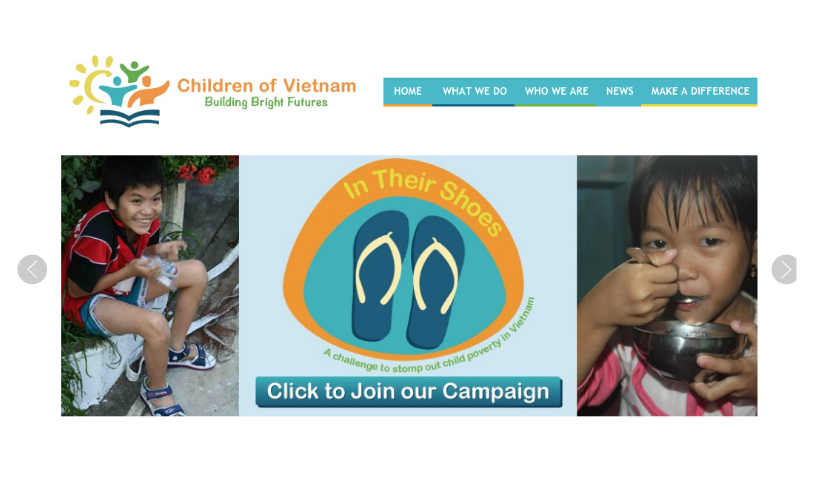
Traditional Media
With so many other avenues available, it’s easy to overlook traditional media. But you really should put some effort into promoting your fundraising campaign through media using one or more of these mediums.
- Newspaper ad that direct people to your fundraising website or a social media account
- Invite your news station to a fundraising event
- Send out a press release
- Ask a board member or major donor to write a letter to the editor detailing your fundraising campaign
Once you’ve gotten a donor/prospects attention through traditional media and you’ve directed them to your website or social media, they’ll be directly in the midst of all your additional marketing efforts across multiple channels.
Phone
In some cases, a handful of your donors may prefer to be reached out to via phone and it’s important to honor this. Not too long ago, nonprofits used telephone calls to reach out and connect with our donors and this avenue has really fallen by the wayside in recent years.
If you’re truly looking to reach out to as many people as possible, never overlook those donors who like to receive a phone call.
Partnerships
Nonprofit and business partners are a great asset to your marketing plan.
- Nonprofits: Partnering with organizations that work in the same capacity or that serve similar client groups/causes helps promote your mutual efforts and the result is often larger than that of a single fundraising effort. Combining paid marketing efforts helps cut down on fundraising and administrative costs, which is a great bonus!
- Businesses/Corporations: Local businesses in your region are looking for nonprofits to partner with, whether it is for volunteering or other corporate social responsibility-driven reasons. The first step is to get on their radar by scheduling a meeting. Then, present a impact-driven plan to raise money and create change in the community. Offer ways for employees to not only contribute, but to get involved as strategic planners, volunteers, and personal fundraisers.
Before you begin a partnership with either another nonprofit or business, set guidelines and expectations. If there is any splitting/distribution of money and duties, create a clear memorandum of understanding.
Putting It All Together: Creating A Communications & Marketing Plan For Your Fundraising Campaign
Now that you have a good grasp on all the channels available to promote your fundraising campaign, it’s time to put it all together. Since the last thing you want is a scattered, ineffective marketing strategy, the best way to stay organized is to create a detailed plan.
If you’re familiar with a fundraising plan/calendar, than this should be a fairly simple process for you and your organization. Follow these steps to create a communications and marketing plan for your fundraising campaign.
- Planning Stage: Confirm this information:
- Campaign start/end date
- Theme
- Goal
- Desired impact
- Create a timeline from the beginning to the end of the campaign
- Note key dates
- Note any weekly/monthly themes
- Detail each communication and marketing channel you intend to use. Including the following:
- Date/time of message
- Target audience
- Marketing channel
- Message content
- Desired outcome
- Determine and explain how you will track the progress of every “outreach”/touch point
- Put it all together in a spreadsheet or table
Here is a sample communications and marketing plan for a fundraising campaign.
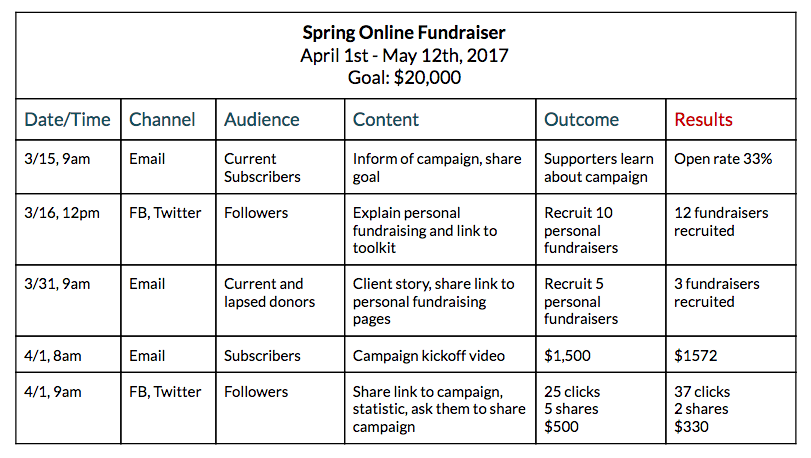
Promoting Your Peer-to-Peer or Crowdfunding Fundraising Campaign Using CauseVox’s Integrated Features
When we built CauseVox, we did so with efficiency in mind. We wanted to create a platform that translated well across multiple marketing channels. In addition, the features you see below weren’t just designed to make your fundraising experience more streamlined, we incorporated them to make People Fundraising even easier for your supporters.
Check out these 5 ways that you and your supporters can promote your CauseVox-based campaign across multiple channels.
1. Blog & Impact Updates
Share your campaign status and updates using CauseVox’s blog feature. To create, update, and share blog posts, head to your Account page, click Manage and select Blog.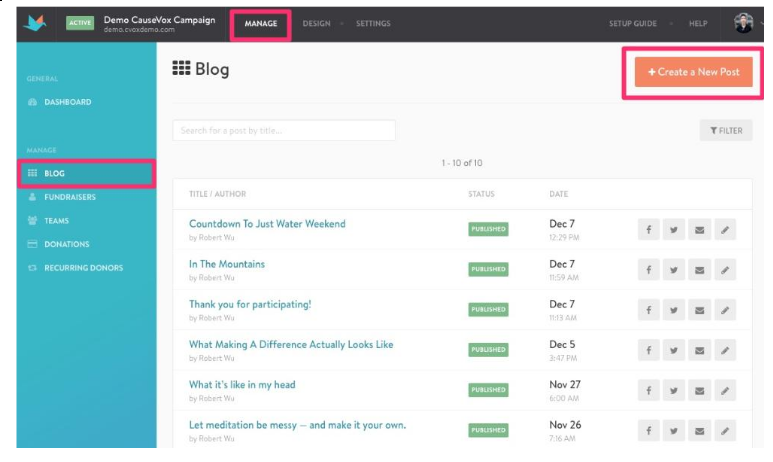 2. Social Media Sharing
2. Social Media Sharing
Use CauseVox’s social media buttons to share your campaign’s progress, link to your website, and recruit personal fundraisers. To set up social media sharing, go to your account Settings, select Display Options, and then Social Sharing.
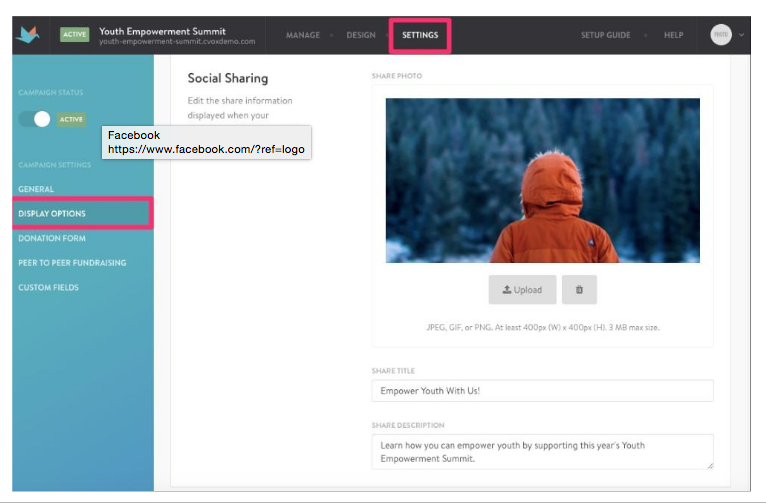 3. Mobile Optimization
3. Mobile Optimization
CauseVox-powered fundraising websites are mobile optimized to make it easier to people to view and give to your cause.
4. Website Integration
To promote your campaign on your website, simply install a Widget. Then, you’re fundraising website will remain front and center for all your website visitors to see.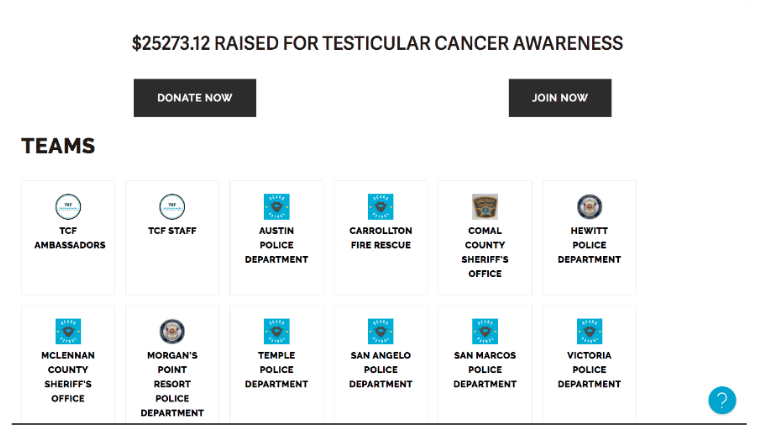
5. Other Integrations
Using Zapier, you can now connect your CauseVox account to 500+ fundraising software programs, including MailChimp, Salesforce, and Constant Contact. It’s now easier than ever to send emails, pull donor data, and maximize your online marketing efforts.
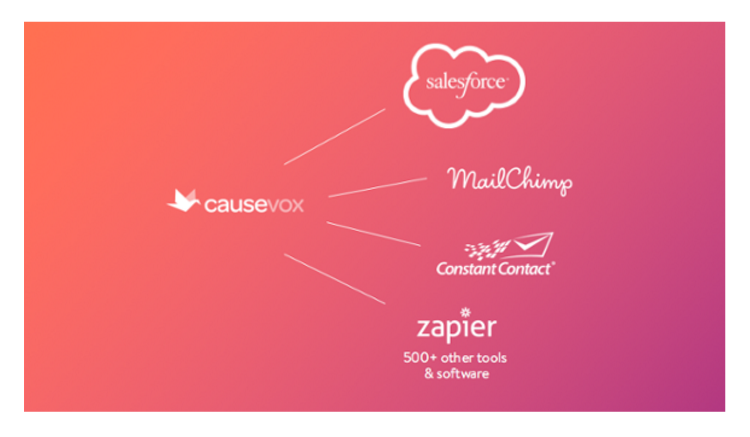
Are You Ready To Promote Your Next Fundraising Campaign?
You now have all the information and tools you need to effectively promote your next fundraising campaign. Moving forward, focus on all the marketing channels you need to get in front of as many potential donors as possible. By using a mix of online and traditional methods, you’re bound to reach an exponentially large number of people eager to support your cause.
“Focus on all the marketing channels you need to get in front of as many potential donors as possible.” tweet this
To help round out your marketing efforts, check out our other relevant fundraising resources:




